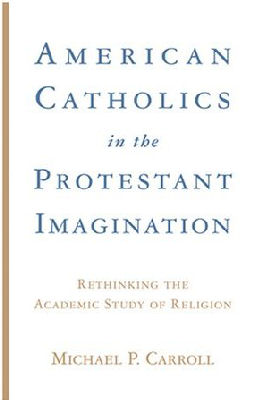
|
Posted January 11, 2008
Book: American Catholics in the Protestant Imagination: Rethinking the Academic Study of Religion Author: Michael P. Carroll John Hopkins University Press. Baltimore, MD. 2007. Pp. 219 An Excerpt from the Jacket:
In this provocative study, Carroll explores a number of historiographical puzzles that emerge from the American Catholic story as it has been understood through the Protestant tradition. Reexamining the experience of Catholicism among Irish immigrants, Italian Americans, Acadians and Cajuns, and Hispanics, Carroll debunks the myths that have informed much of this history. Shedding new light on lived religion in America, Carroll moves an entire academic field in new, exciting directions and challenges his fellow scholars to open their minds and eyes to develop fresh interpretations of American religious history. An Excerpt from the Book: Although different investigators come up with slightly different lists when identifying what is distinctive about Hispanic Catholicism, the one element that appears on almost all such lists is the claim that Hispanic Catholicism has a “matriarchal core.” The following remarks are typical: It is to be noted that both in Spain and America, women who are barred from the ordained ministry play a very important role in religiosidad popular. The mother [or grandmother] is the great leader of prayer and transmitter of religious lore and values. Rezadoras are much more common than rezadores. (Vidal 1994. 85) . . . The leadership of prayer life in the Hispanic community has traditionally been a feminine role. The main practitioners and promoters of popular religiosity are women. The first ways and words of prayer are taught by the abuelas (grandmothers), mothers, women religious and catechists. It is from them that the feeling of prayer, the holy, the love of God, Mary and the saints is transmitted. (Perez 1994. 380) Family life is stronger among Latinos than among other Catholics. Women (Latinas) are more active in parish life and devotional life than Latino men, and commonly religion is defined among Latinos as being the women’s domain. (D’Antonio, Davidson, Hoge, and Meyer 2001, 154) . . . The claim being made in passages like these is not only that women are more likely to participate in religious activities (the feminization that is quite common in both the American Catholic and American Protestant traditions) or that women take charge of activities within the household unit, including those relating to religion; rather, the claim is that women, older women in particular, have been especially likely to take on leadership roles in connection with communal religious activities in Hispanic communities. The “matriarchal core” hypothesis is of course entirely plausible. It is not difficult to imagine that under certain circumstances (say, for example, a scarcity of priests) women in a Catholic community might well take on such roles, both within the household and in regard to communal events. Indeed, that is exactly what seems to have happened in the Cajun communities discussed in the previous chapter. But suppose we ask the same sort of question that we have asked in connection with Irish American Catholics, Italian American Catholics, and Cajun Catholics; What is the empirical basis for believing that Hispanic Catholicism has a matriarchal core? The answer, as I now hope to demonstrate, comes close to “there isn’t any basis.” Table of Contents: 1. How the Irish became Protestant in America 2. Why the famine Irish became Catholic in America 3. Italian American catholicism 4. Were the Acadians/Cajuns really good Catholics? 5. Hispanic Catholicism and the illusion of knowledge 6. Protestantism and the Academic study of American religion An enduring alliance Epilogue |
|
